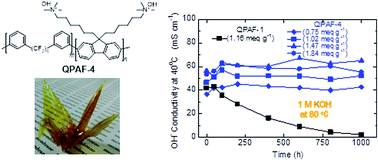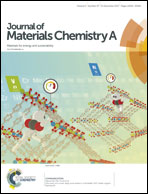Robust anion conductive polymers containing perfluoroalkylene and pendant ammonium groups for high performance fuel cells†
Abstract
A novel series of ammonium-containing copolymers (QPAF-4) were designed and synthesized as anion exchange membranes for alkaline fuel cell applications. The copolymers were prepared via a nickel promoted polycondensation reaction with high molecular weights (Mw = 72.7–276.4 kDa as precursors) and were composed of perfluoroalkylene and fluorenyl groups with pendant ammonium groups. The QPAF-4 membrane with optimized copolymer composition and ion exchange capacity exhibited high hydroxide ion conductivity (86.2 mS cm−1 in water at 80 °C) and excellent mechanical properties (large elongation at break = 269%). A severe alkaline stability test of the QPAF-4 membranes in 1 M KOH at 80 °C for 1000 h and the post-test analyses of the 1H NMR spectra, solubility, and mechanical properties revealed minor, or no, changes in the chemical structure and properties. Alkaline fuel cells using the QPAF-4 membrane were operated using hydrazine as a fuel and oxygen or air as oxidant to achieve the high maximum power density of 515 mW cm−2. The durability of the membrane was also confirmed in the operating fuel cell at a constant current density for longer than 1000 h.



 Please wait while we load your content...
Please wait while we load your content...